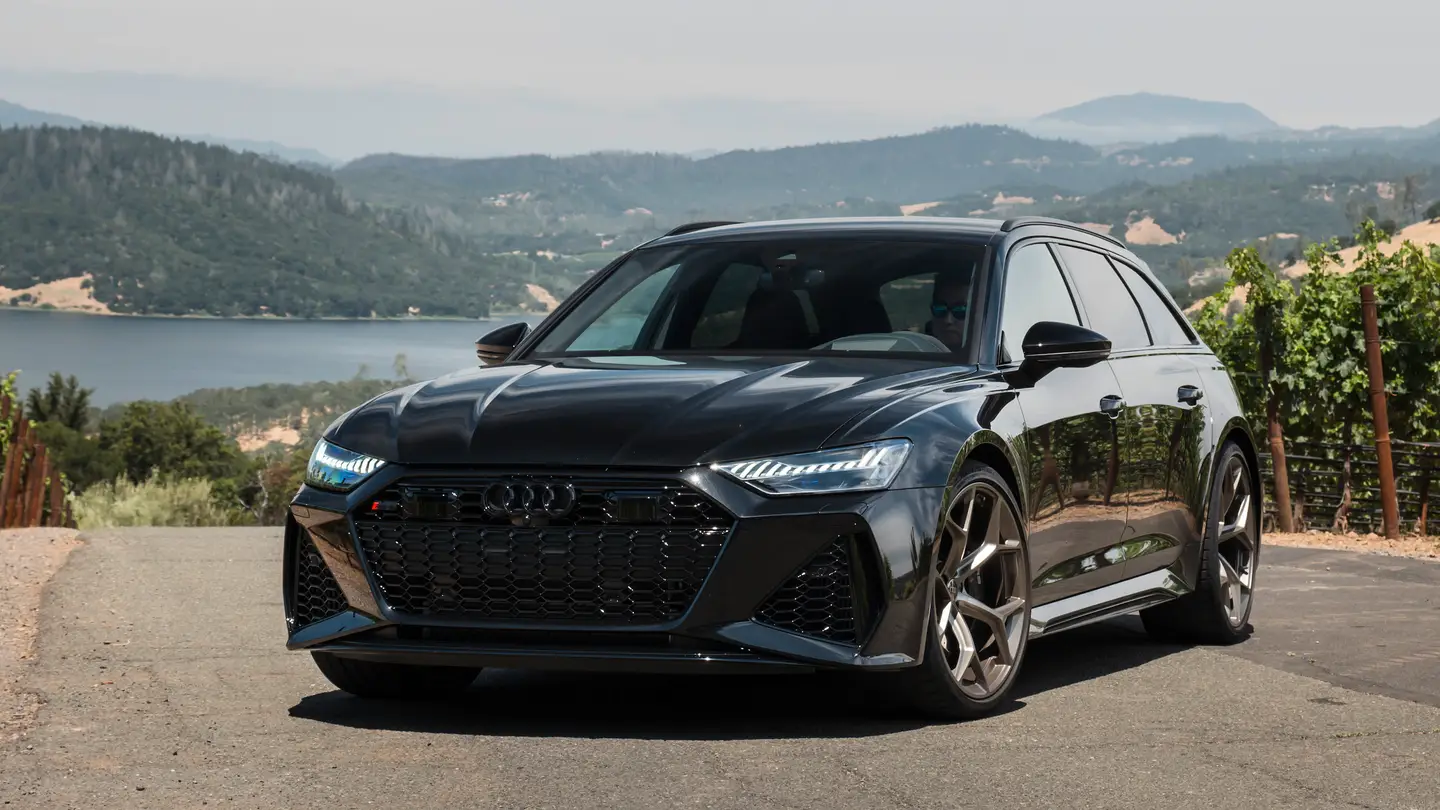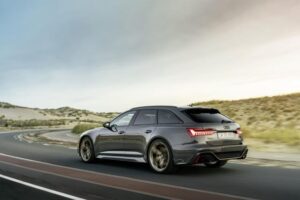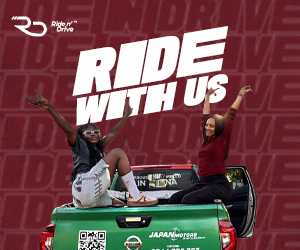Americans on a whole aren’t known for taste in cars. We’ve got an insatiable appetite for gargantuan trucks that turn shopping centers into monster truck rallies, with massive land yachts (some call these SUVs) there to spectate. It’s only rational, right? Real estate is always a sound investment, and we must be doing OK in life if we claim as much as possible wherever we park.
Is a sport wagon much more practical? Not really. Which is why they belong in America. Fortunately, Audi agrees and gave us the RS6 Avant for the 2021 model year after a decade had passed without a single sport wagon from the brand. We won’t harp on that too much, because now Audi has delivered again with the 2024 RS6 Avant Performance bringing more power, a more aggressive look, better handling, and a louder exhaust. It’s the kind of outlandish extravagance we need more of on our roads.

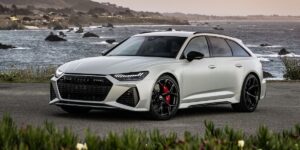
Exterior Design
Part of the appeal of a sport wagon is that many see it as a sleeper, with its performance hidden beneath the dull utilitarian design of a sedan with an inflated rear end. The RS6 Avant doesn’t fit that description. You know exactly what this vehicle is capable just glancing at it.
The aggressive look of the previous-generation RS trim is updated from gloss black to matte gray on the mirror housings, front spoiler, roof rails, rear diffuser, and side window trim, with 21-inch 10-V-spoke star design cast aluminum wheels standard. Two new exterior colors, Gerenadier Red metallic and Ascari Blue metallic, have been introduced for eight total options.
The optional 22-inch five-Y-spoke forged and milled lightweight wheels reduce unsprung mass by 11 pounds and are offered in the three different finishes. A matte titanium finish is a stand-alone option. The Black Optic package gives the wheels a two-tone black finish and changes the exterior components to matte black. The Carbon Matte package adds a matte black finish, with the exterior adorned in matte carbon trim.
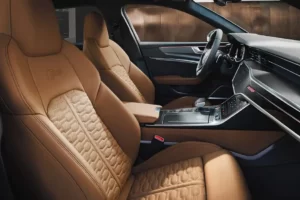
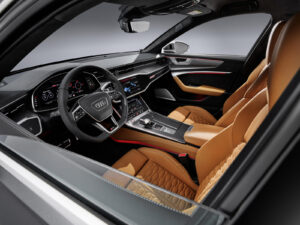
Interior Design
The new RS Design Plus package is available in grey, red, and blue. The gray and red options have black seat belts with color-matched stitching on the border and a carbon twill inlay across the dashboard. The flat-bottomed Alcantara steering wheel has colour-matched stitching, along with the floor mats and sides on the center console. Dinamica microfiber covers the shift lever and armrests to give a comfortable and durable feel. Valcona leather seats with perforated honeycomb stitching complete the look with a red, blue, or gray RS logo. Opting for the Blue package changes seat belts to a solid Ocean blue and adds blue stitching in the carbon twill dash inlay. The blue interior with Ascari Blue paint is a sight to behold.
The 12.3-inch gauge cluster adds some new performance-oriented flavor. A blinking shift indicator in manual mode adds a race-inspired element with transitioning green, yellow, and red lights helping the driver anticipate and click off perfectly timed gear changes. It’s doubtful that you’ll beat the automatic eight-speed, but some thought was put into the usability for those insisting on complete control over their machines.
The center screen is still split into upper and lower sections instead of one giant one, a design that suits the upscale but subtle interior. The center screens have unique haptic feedback that you will either love or hate (I happened to love it). Operating the screen takes a dedicated push like a real button; it doesn’t respond to instant touch like we are used to with our phones. This prevents unwanted touches and lets you put your finger exactly on target before selecting. The feedback isn’t just a vibration like you feel with your phone, either. A hammerlike apparatus taps the back of the screen; you would swear you were pressing a button. People love their buttons, and this experience re-creates the feel more faithfully than any other screen.
While Audi of America originally had to plead with the home office to bring the RS6 Avant to the U.S., the Germans are now giving us an Easter egg not found in the Euro-spec cars. Commemorating the first vehicle wholly developed by Quattro GmbH, the gauge cluster can be switched from the standard black to a white display with digital gauges based on the 1997 S6 Plus. (Unfortunately, Audi used Euro-spec vehicles for the media launch, and we didn’t see it first-hand.)
Specifications
The 2024 RS6 Avant Performance earns its “performance” moniker by increasing power from 591 hp to 621 hp and increasing torque from 590 lb-ft to 627 lb-ft over the 2021 RS6. Audi powertrain engineers accomplished this by adding larger turbos to the 4.0-liter V-8 and increasing boost by 3 psi. These numbers are good for an advertised 0-60-mph claim of 3.3 seconds, 0.2 second quicker than the previous model. The outgoing car scored a 3.1-second 0-60 time in MotorTrend testing, though, so this one should squeak under 3.0 seconds. Activating launch control is as simple as putting the car in RS2 mode (the only mode where ESC can be completely disabled) and holding the brake and gas to the floor. An icon resembling a drag-racing Christmas tree appears in the cluster to signal the optimal time to launch the car. Are you paying attention, BMW? It should be this easy in your M cars.
The mechanical self-locking center differential, the cornerstone of the Quattro all-wheel-drive system, was updated to be smaller and lighter. Audi refined transmission controls to coax the quickest, most precise shifts possible out of the eight-speed transmission. Gear changes are smooth and precise, with no perceptible harshness.
Both suspension options return for the 2024 model year. In RS1 and RS2 modes, the standard air springs can be customised to use any height setting. The optional sport suspension with Dynamic Ride Control (DRC) has diagonally linked dampers and steel springs for a stiffer and more track-inspired feel, sitting an inch lower than the air-sprung setup. Steel rotors measuring 16.5 inches up front and 14.6 inches in the rear are standard. A carbon-ceramic rotor upgrade bumps the fronts up to a massive 17.3 inches. The 22-inch wheels come wrapped in new Continental Sport Contact 7 285/30 tires, another factor in reducing understeer along with the revamped steering and center differential. From Audi’s testing, the Contis improve handling in wet and dry conditions without sacrificing ride quality or inducing excessive road noise. With the lighter 22-inch wheels, Audi says they shorten the stopping distance from 62 mph by 6.5 feet.
Driving Impressions
Audi knows the RS6 Avant will spend most if not all of its life on public roads, and that’s the experience they prioritised. The Sport Contact 7 was selected for performance and comfort to avoid putting a car out there that could only handle one perfect condition. It’s by no means an all-season tire, but the car won’t turn into a death trap in a surprise rain shower. Road noise is not just quiet for a performance tire but quiet in general. Audi removed 18 pounds of insulation to make the exhaust note more noticeable instead of pumping it through the speakers for effect, yet the cabin is still remarkably quiet. Even the stiffer DRC lets the driver feel more of the road while still damping unwanted impact noise.
Steering is light and responsive with slight differences in feel depending on which suspension the car is fitted with. Audi engineers told us steering tuning was the same in both, and the tighter feel we experienced in cars equipped with the DRC is a result of the change in overall vehicle dynamics. Understeer was nonexistent even through the uphill 90-degree corners we found on Northern California’s playgrounds, and the RS6 Avant felt perfectly balanced transitioning through winding roads, pushing as hard as we could get away with.
Audi’s engineers put more effort into separating drive modes, and it was effort well spent. Between Efficiency, Comfort, and Dynamic modes (selected on the center console), the car has plenty of character to suit any situation. The RS1 and RS2 modes (found on the steering wheel) make the car more aggressive with customizable engine modes, steering, suspension, exhaust level, and ESC. The RS button on the steering wheel also toggles to Auto mode, which calls up the last drive mode selected (Efficiency, Comfort, or Dynamic) and serves as the startup default.
What Could Be Better?
There isn’t much to dislike about the RS6 Avant Performance. But with all the effort to turn up the exhaust note in the cabin, it could still be louder. We drove Euro-spec cars with a particulate filter in the exhaust, so it may be a bit louder in the U.S. production cars. The RS6 wagon is also noticeably quieter than the RS7 Sportback. Audi assures us they are tuned the same, and any perceived difference is due to the different body shapes. The exhaust sounds great, and this is an incredibly minor complaint because there isn’t much else to improve.
Speed is electronically limited to 155 mph, even with the upgraded wheels and brakes. The 2021 RS6 Avant without “performance” tacked to its name could hit 190 mph with the big brakes. Honestly, though, so what? Tuning a car for the road doesn’t require going that fast, and the RS6 holds its own as a great driving car.
If you’re really that bummed about the top speed, the Bronze edition exclusive to the North American market will add Sebring Black crystal effect paint, 22-inch matte neodymium gold wheels, black callipers, gloss carbon exterior accents, bronze interior stitching, and a top speed of 174 mph. Go ahead and complain that it still isn’t 190 mph, but it feels like grasping at straws.
Verdict and Cost
The Audi RS6 Avant handles great, looks great, and sounds great; it’s a classic “looks like a duck, sounds like a duck” situation. With a price tag of $126,895, it’s going to be out of reach for most, but it falls right in line with its competitors. The RS6 Avant Performance does what it does so well, it goes from an almost unremarkable daily driver to loud and ferocious at will, but it always feels like it’s under control. The beauty of designing a car for the road instead of sticking road-legal equipment on a race car is that you can actually drive it on the street. With the utility of a wagon, it’s a performance car—emphasis on car—that’s as practical as an SUV for daily use. Cars start hitting our shores this fall, so now would be a good time to start saving. Maybe start a pool with your friends and alternate weeks—it’s worth that hassle.
source: motortrend



